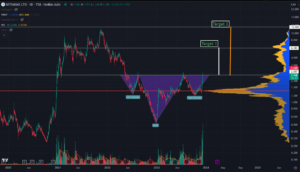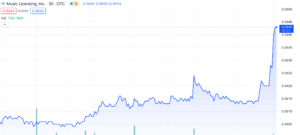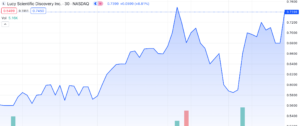Emerging Markets
Asia Broadband (OTCMKTS: AABB) Bullion & Crypto (Tequila, Bonanza, Zodiac)
Published
2 years agoon
By
Boe Rimes
Asia Broadband (OTCMKTS: AABB) is moving northbound in a hurry in recent trading as volume and interest have picked up substantially. AABB was one of the biggest runners of 2021 skyrocketing to highs of $0.659 per share in February before coming back down and forming a base at a dime. In December the stock ran again to highs of $0.33 before the latest dip. AABB is among the most exciting stocks in small caps with an enormous investors following including some of the most powerful players in small caps.
Asia Broadband: Traditional Mining Meets Modern Day Alchemy
- Nevada-based junior gold miner acquired five promising new mining properties
- Capitalizing on crypto space to support a unique business model
- Undervalued compared to its junior mining peers
- Little to no value attributed to paradigm changing cryptocurrency and digital business segment poised to drive future value
- AABB is a speculative yet compelling early-entry investment that presents some inherent risks with possible high reward.
The management team at Asia Broadband (OTCMKTS: AABB) is redefining what it means to be a junior miner, bridging together the physical and digital worlds and ushering traditional mining into the modern age via the blockchain. The company is looking to generate profitability by developing shovel-ready resources and then selling the gold directly into the marketplace via its gold-backed cryptocurrency. If this unique, vertically integrated “mine-to-token” business model succeeds, AABB believes they can simultaneously solve the lingering problem preventing cryptocurrencies from being considered more than just a volatile store of value.
Subscribe to Our 100% Free Penny Stock Newsletter. We Have Something Big Coming!
Creating a Store of Value
From the beginning, critics of cryptocurrency have lamented its lack of tangible value and inherent volatility. While that may not be an issue for everyone, there is a growing movement and market among investors hungry for cryptos that provide some form of tangible backing. Enter AABB. In 2020 the company released its gold-back digital currency, AABBg. The token is backed by $30M in bullion held in stores by the company and its price directly tied to the spot price of .1g of gold. The company recently released the mobile version of its own proprietary crypto currency exchange, becoming one of only a small handful of publicly traded exchanges and delivering a major milestone–and potentially significant revenue stream–along the way.
But while the cryptocurrency component may have stolen much of the recent thunder, the company hasn’t neglected its resource-driven roots and has been busy putting the “mine” in “mine-to-token.” In the span of six months, they’ve gone on an asset acquisition binge, purchasing or entering into LOIs on five mining properties at various stages of development and production, all in prolific mining regions of Mexico. They’ve also opened new processing, warehousing and office facilities.
A Compelling Opportunity
The company’s cryptocurrency component generated a lot of buzz and attracted a large, loyal base of shareholders, but AABB is still a relative unknown in this increasingly crowded and competitive field. At the same time, its crypto component has largely obscured its mining progress, which looks promising on paper, but is still in its infancy. The amalgam of crypto-meets-mining makes for a unique, vertically integrated business model but it obscures the investors ability to arrive at an accurate valuation. Investors focusing on gold mining would realize it is trading at the lower end of its potential. Almost no valuation is reflected in the innovation of its gold-backed token and digital assets, which makes this a compelling opportunity as those gain traction.
A Brief History
Like many OTCs, the company that AABB was when it began is not the company it is today. The original company was incorporated in 1996 as Gemini Marketing, but in 2000, after various iterations, took a controlling interest in China-based Shanghai Broadband Network and subsequently changed their name to Asia Broadband. They eventually exited the broadband business altogether. While the ticker has changed hands over time, the name has stuck, and in 2015, the new Asia Broadband entered the mining business with purchase of the Guerrero Gold Mine, in Guerrero, MX, focusing on the production, supply and sale of precious and base metals, primarily to Asian markets. This direct distribution network into the Asian metals markets is a key differentiator in its vertically integrated model.
Sales grew and the company acquired two additional mining properties with the help of a Chinese-based JV partner, Qiangda Investments. In late 2020, they sold the Guerrero mine to Qiangda for $52MM in cash, $30MM in physical gold which now backs the AABBg token.
A Growing Portfolio
With cash and gold in hand, the company shifted its acquisition focus to targets in Mexico that have “high potential mineralization…and offer substantial value-added opportunities rapidly to expand asset values.” They also brought in new management to execute on that plan, capitalizing on the new team’s established global networks and localized knowledge of the Mexican mining, business and political landscapes.
In the last six months, the company has purchased or entered into Letters of Intent on five properties where they feel they have “a comparative advantage of development resources and expertise.” The company seeks shallower mines that have high grade known vein structures. While production volume may not be large, mineralization is high, making production scalable and profitable.
- Tequila – Jalisco, MX, concession # 219165. October, 2021. 75% Joint Venture interest & 100% of current and future gold production from the 66.7 hectare property. Previous findings from the former Timmins Gold returned economic gold grades over appreciable widths from 14 of 18 holes.The property is now producing gold, silver and base metals from its 50 ton per day processing facility with plans to double that production capacity within the next six months.
- Bonanza – Nayarit, MX, Concession # 221977, November, 2021. 19.25 hectare property. 100% $6,000,000 split into $2,000,000 cash and $4,000,000 million restricted shares. The property has shown high-grade gold assay results from recent samples and drilling activities with the most significant gold values of more than 10 grams per ton (g/t).
- Zodiac – Buen Pais, MX, Concession, # 218704, March, 2022. 200 hectares. 100% interest. $700,000. includes150 ton/day capacity processing plant. Assays in the geological report revealed high-grade gold and silver values from non-targeted rock samples that were randomly collected. Some of the most significant high-grade gold values were 101.6 (g/t) and 26.2 (g/t).
- Zodiac II & III – Buen Pais, MX, March, 2022 – Letter of Intent on both properties.
- Warehousing and Operations – The company opened a new mining operations storage and processing facility in Buenavista, Jalisco, Mexico, and a central operations office in Mexico, City, MX.
- In 2022, the company discontinued development at their existing properties, Los Reyes and Colima, deemed “comparatively not feasible to justify rapid development.”
Closing on the remaining zodiac properties brings the company’s total footprint to more than 300 hectares (741 acres) in a country that is among the top ten largest producers of gold in the world. In all, the company incurred $1,373,092 in exploration and development costs reported in their 2021 Annual Report. Further geological assessment is ongoing but the company said it was “highly encouraged” by assays from geological reports, core sampling and other data.
$AABB $AABBG.X “In a nutshell, with its growing line of products, Asia Broadband aims to become a world leader in providing a standard of exchange of excellent quality, secure, transparent, trusted, and backed by gold. It's just a matter of time.”
— Jimm Emily Ann StockWatch (@JimmEmily090) May 16, 2022
To Find out the inside Scoop on AABB Subscribe to Microcapdaily.com Right Now by entering your Email in the box below
From Bullion to Bit
With the ink still drying on their mine deals, their cryptocurrency operations are also just ramping up. The company engaged with Toronto-based Core State Holdings to not only develop the AABBg token but create the digital infrastructure to facilitate its use worldwide.
They launched AABBg in 2020 with the goal to make it “a world-wide standard of exchange that is stable, secured and trusted with gold backing, while having the added benefit of demand-based price appreciation.”
The initial token release was 5,400,000 and the company has since sold more than 470,000 tokens generating $2,719,940 in revenue for 2021.
According to Arcane Research, market capitalization of gold-backed tokens increased by 60% in 2022 to surpass $1 billion. A promising statistic on its own for anyone producing an asset-backed coin. However, AABB feels it has distinct differences that separate its token from the others. First, none of their current peers in the Gold-Backed token space (PAX Gold PAXG, Tether Gold XAUT, e.g.) mine their own gold. AABBs mine-to-token model is truly unique. Second, other gold-backed tokens are designed primarily to facilitate the trading of gold in digital form—they simply take the age-old practice of trading & investing in gold as a store of value and put it on the blockchain. AABBg provides that same ability, but its ultimate goal with their token is quite different. The Company “strives toward cryptocurrency only exchanges and complete independence from FIAT currency.” Rather than just facilitating the trading of gold, AABB aims to facilitate the use of gold as a digital currency – to allow merchants, customers and individuals to transact using the AABBg token, and do so worldwide on their proprietary wallet and exchange.
The company’s cryptocurrency wallet has been available for free on GooglePlay (GOOG) and Apple App Store (APPL) since 2021 and supports more than 400 coins or tokens, with more than 10,000 downloads and an average review of 4.7 out of 5.
The desktop version of the cryptocurrency exchange was released with limited trading pairs toward the end of 2021. Additional pairs were added over time, and the mobile version—in both English and Spanish—was released in March, 2022. The proprietary, decentralized cryptocurrency exchange is uniquely embedded within the wallet itself and is completely fiat-free. It facilitates trades of the AABBg token as well as various other cryptocurrencies. At last count, the company had more than 90 pairings available for trading, including BTC, ETH and XRP as well as so-called meme coins like APE, Doge, Shiba and more. The company plans to have more than 200 pairs available as the exchange develops.
Crypto-Related Revenue
The company spent $752,255 on digital development in 2021 and generated $45,872 in exchange fees on top of token sales. The company’s $2,765,812 in gross profit was driven exclusively by the new digital assets segment, with net income of $1,013,726.
The company has yet to release any official numbers on exchange volume. Based on average daily volume and average pricing of each pair available on the exchange, AABB’s exchange now averages around $1M in trading volume per day, putting it on pace to handle more than $365M in volume per year. Depending on the fee generated at time of trade, that translates into about $2-$7M in annual revenue. Keep in mind, this is prior to any major marketing efforts and just a few months into the mobile version’s release.
For comparison, Binance, the largest exchange in the world, generates more than $17B in 24-hour volume, Coinbase (COIN) around $3B. The top-ten cryptocurrency exchanges are bringing in as much as $3 million per day in profit, according to Bloomberg. While AABB’s exchange may be a long way from those astronomical numbers, early usage without any marketing is encouraging. According to Nomics.com, average daily volume for an exchange is just over $2B, the median around $250M. Even if AABB were to hit the lower 25th percentile, they could still see around $65M in volume per day, generating almost $120M in yearly revenue based on a conservative .5% trading fee.
FinTech, E-Commerce and Additional Digital Revenue via PayAABB
Two months after El Salvador announced it would accept Bitcoin as legal tender, AABB established a satellite office and subsidiary there to serve as their Central and South American operations hub. AABB feels they’re token presents a compelling alternative to offset the volatility of Bitcoin, and plans to primarily target retailers.
The company has yet to divulge exactly what it has in store, but has hinted at a new digital asset offering, PayAABB, that could go well beyond El Salvador and instead bring crypto e-commerce capabilities to the global retail masses. PayAABB will offer plug-ins to popular e-commerce sites like Shopify (SHOP) and WordPress. The PayAABB merchant platform and payment gateway will also facilitate crypto payments via messaging applications such as WhatsApp, social media sites and email as well as invoicing, loyalty/reward programs, broker modules and crypto-backed loans.
As El Salvador has shown, merchant & mass adoption of crypto as a functional currency is hampered by Bitcoin’s volatility and transactional inefficiency. PayAABB aims to resolve these issues by providing a holistic digital platform that can be quickly set up within the retailer’s existing Web or Point Of Sale (POS) systems and allow businesses and merchants to accept all forms of cryptocurrencies in store or online. Retailers can then utilize the company’s exchange as part of the PayAABB suite to reduce their volatility and protect their profits by converting their Bitcoin or other accepted cypto into a stable coin such as AABBg. In addition to the added stability, they could see additional profit if the price of gold goes up post-sale. When PayAABB is formally rolled out, it not only quickly enables retailers to offer crypto e-commerce capabilities, but opens the AABB exchange, wallet and token up to an established and tech-savvy user base and the gargantuan global e-commerce market.
The company also plans to enter the NFT space and “has been in discussions to create multiple NFT marketplaces for unique digital content categories.” They also announced a licensing deal with fellow OTC company KYN Capital Group (KYNC) and are looking to expand their network of business clients and contacts as another revenue stream.
Lastly, the company stated they were “in discussions to explore the creation of a cryptocurrency mining facility in El Salvador powered by geothermal energy.” No additional information has been provided, but cryptocurrency mining presents a unique and profitable revenue stream on its own, let alone when it’s vertically integrated into their existing model using geothermal energy.
Trading Volatility
There are currently 2,500,000,000 authorized shares (AS) and 2,468,944,960 outstanding (OS). In 2021, the company not only paid a 45-1 restricted share dividend, but retired 120,000,000 shares. Despite the share reduction, weighted average shares increased by more than 900M since last year, though the AS has remained unchanged year-on-year. The company is also no stranger to convertible debt, but has stated the initial capital of the largest in-force convertible note was critical at the time and they maintain a professional relationship with the noteholder, Whitecastle Capital Corp. Per the financials, the outstanding balance on that note is $701,416.
With an authorized share count almost maxed out, this outstanding debt and its potential for continued dilution or share restructuring likely gives many existing and potential investors pause. The company has previously indicated they would retire additional shares, but has yet to announce any formal plans or timeline. In late April, the four directors of the company paid a combined $2.8M for the purchase of 28 million non-convertible, preferred shares at a par value of $0.10 per share. Each share has 100 voting rights and equal participation with common shares for all future dividends. The Company President and CEO, Chris Torres, purchased $2.4 million of the total issuance. The entire $2.8 million share sale proceeds will be allocated to the company’s capital expansion programs.
Like crypto, the stock has seen its share of volatility. Following the announcement of its crypto plans in 2020, the stock soared, running from .06 to more than .60 in just four trading days and generating a lot of buzz in its wake. It has since settled in a range with the current 50-day MA hovering around .10. Per available data, the stock has seen an average of 35% daily short interest.
Valuing a New Business Model
At today’s numbers, the company is sitting with a Market Capitalization hovering around $185,000,000. AABB’s earnings per share (EPS) is up 191% year-on-year, from .012 to .035. The company has a trailing price to earnings (P/E) ratio around 3.5 vs mining industry average of around 10.7 as reported by SimplyWallStreet.com. The company’s PEG ratio is just .02, vs an industry average around 8.9 according to Zack’s.
The price of gold as well as the AMC (AMC) / Hycroft (HYMC) deal has brought some renewed attention on Juniors. For those new or traditional mining & metals investors looking for new targets, AABB is trading roughly seven points off the industry average P/E and more than eight points off the average PEG and is undervalued based on most other metrics. With one property now producing, additional projects in the pipeline, the ability to ramp into production quickly and a vertically integrated business model that should yield greater margins, the company presents a limited downside entry opportunity based on its mining portfolio and future potential alone. The company’s ability to tokenize the gold almost as soon as it leaves the ground and generate additional profit each time it trades on the exchange is a unique revenue source no other junior miner can currently claim.
Comparison to peers in the Fintech and cryptocurrency space is more difficult and that lack of comparables may make investors skittish.
COIN, the largest publicly traded exchange, has a trailing PE ratio around 13.
AABB is often compared to fellow OTC fintech Voyager Digital (VYGVF). At their last report, VYGVF had a market cap of $1.14B, with $164M revenue–a +4,518% increase–and a forward looking P/E of 9.4 at time of writing.
VYGF, COIN and others are all revenue-generating, proven business models that have what many consider the most important determinants of value in that space–users and funded accounts. Cryptocurrency companies and fintech startups also often enjoy wildly optimistic and inflated valuations seemingly based on hype alone. AABB is generating revenue, but it does not (yet) have the hype and they don’t (yet) have the users. They also have provided no forward looking guidance on future earnings or specific long-term objectives. Based on those metrics and a lack of insight into where the company is headed, when it comes to their digital assets, AABB’s current share price may, in fact, be a relatively fair valuation of where many investors think the company is today, but it is not indicative of where they could be tomorrow.
While its digital assets may be difficult to value, they are now generating revenue and the potential for that revenue to increase significantly–and the valuation along with it– is what makes it such a compelling opportunity. AABB stock ran 900% when it simply announced its crypto intentions. That run had hype, but was also reflective of the investment community’s interpretation or prediction of future value at the time. While the hype may have died down, the company has done nothing but deliver since. A similar run today would push the share price closer to $1.00. Generating that type of momentum this time around could happen quickly again via a significant catalyst but it could also be driven less by hype and instead more organically by a few quarters of increasing revenue, user growth and positive forward-looking guidance.
Risks
The elephant in the room is dilution; however, the balance of power has shifted toward the company as the share structure reaches its maximum capacity. Savvy investors have reason to be leery, but should also realize this shift in power could reap substantial returns upon the announcement of a debt restructuring. Their launch of PayAABB and the successful execution of their El Salvador strategy could be the proverbial icing on the cake that finally makes their digital assets an integral part of their current and future valuation.
For all these reasons, to investors in both the mining and cryptocurrency spaces or for those not afraid to take some added risk, the entry point is low, the downside limited and the potential for reward is high.
Investment Summary
AABB has disrupted more than 100 years of traditional gold mining whereby gold is mined, processed and eventually sold off to a refinery to make its way into the market. For almost all junior miners, this is the business model. Valuation is based primarily on a discounted formula of what is proven or confidently estimated to be in the ground and what it can fetch after various items are factored in.
In less than two years, AABB has effectively vertically integrated the entire process and ushered it into the digital age. Gold can now be mined, produced and sold directly to the end user. Anyone can now use gold as a digital currency to pay for goods and services anywhere in the world without the spectre of volatility. All of this and more can be done right now, seamlessly, anonymously, via one application on your smartphone.
The mine-to-token business model is unique, but even traditional valuations based on a simple gold-in-the-ground formula reveal a very undervalued stock. Investors seem to be struggling with the lack of audited financials that an uplisting could cure and the company has stated uplisting to a major exchange is a primary corporate goal. Investors also seem to struggle with a name that belies the innovative junior miner behind it, though the company has embraced the ticker in branding for its digital assets and has a subsidiary, Asia Metals.
There are also new entrants to this model like Osceola Gold (OSCI) which seem to be jumping on the bandwagon by recently announcing their own plans for a stable coin. Others, with bigger pockets and more resources, could follow suit, so AABB needs to capitalize on their first mover advantage. As of late, AABB’s management’s strengths are primarily focused on finding new, attractively priced gold assets to bring under the AABB umbrella. The commencement of new production runs this year could represent major catalysts to come and the company is well funded with a strong balance sheet to see it through. We will be updating on AABB when more details emerge so make sure you are subscribed to Microcapdaily so you know what’s going on with AABB.
Subscribe to Our 100% Free Penny Stock Newsletter. We Have Something Big Coming!
Disclosure: we hold no position in AABB either long or short and we have not been compensated for this article.
You may like
-


Asia Broadband, Inc (OTCMKTS: AABB) Stock Price Surges as the Firm Takes a Stance Against Market Maker Manipulation Practices
-


Junior Gold Miner Asia Broadband $AABB Enters Web3 Space by Launching Golden Baboons Mining Club NFT Project
-


Asia Broadband (OTCMKTS: AABB) Coiled Tight and Under Accumulation as Crypto Gold Miner Advances Gold Mining Operations in Mexico & Announces Share Dividend
-


Asia Broadband (OTCMKTS: AABB) Coiled Tight at $0.07 as Crypto Innovator Completes Large Scale Expansion at Tequila Property & Waits on Geological Assessment Report
-


Asia Broadband, Inc (OTCMKTS: AABB) On the Move as Crypto Innovator Signs LOI to Acquire La Paz Gold Mine (NFT, PayAABB Update)
-


Crypto Innovator Asia Broadband (OTCMKTS: AABB) Looking to Breakout Over $0.10 Support Levels (A Look at: PayAABB, AABB NFT, AABB Gold token & AABB Wallet)
Emerging Markets
Bitfarms (NASDAQ: BITF) in Focus: Exploring the Meteoric 110% Surge and Macro Influences
Published
8 months agoon
December 7, 2023
Bitfarms Ltd. (NASDAQ: BITF) rides the wave of explosive growth surging by over 110% from its lows of $1.03 per share in November. This BTC miner has witnessed a 41% increase since last Friday, December 1st, 2023. If you’ve been keeping up with our recent articles, you’ll notice that majority of coverage lacks substantial press releases or filings supporting a surge in valuation. Today’s coverage includes precisely that and more. Let’s delve deeper into BITF to assess if this crypto miner is worth considering amidst the ongoing rise in spot BTC.
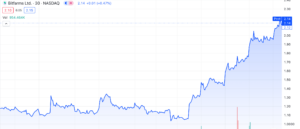 Background:
Background:
Established in 2017, BITF has established itself as a global leader in Bitcoin (BTC) mining. Utilizing its computational power, the company contributes to various mining pools, earning payment in Bitcoin.
BITF sets itself apart by developing, owning, and operating vertically integrated mining farms. These facilities feature in-house management, company-owned electrical engineering services, installation support, and multiple on-site technical repair centers, ensuring a comprehensive operational setup. Bitfarms relies on its proprietary data analytics system, ensuring superior operational performance and uninterrupted service.
Currently managing 11 farms across four countries—Canada, the United States, Paraguay, and Argentina—Bitfarms predominantly uses environmentally friendly hydro-electric power and maintains long-term power contracts. The company remains dedicated to employing sustainable energy sources, often utilizing locally available and under-utilized energy infrastructure.
In its recent upgrade initiative, BITF has improved its fleet’s efficiency and capital practices ahead of the Halving. This strategic move aims to boost its capital-efficient fleet to 12.0 EH/s by Q2 2024. The focus lies in reducing miner and energy costs, enhancing fleet energy efficiency, and fostering greater pricing flexibility for sustained growth and success.
Subscribe to Microcapdaily.com Right Now by entering your Email in the box below.
Subscribe to Our 100% Free Penny Stock Newsletter. We Have Something Big Coming!
Market Update:
At the core of BITF’s latest momentum and strength lies its connection to macro-scale factors. To provide deeper insights into BITF’s future prospects, we’ve conducted a comprehensive market analysis.
The latest market surge propelled spot BTC above the USD $44,000 mark at its peak, reaching its highest value in more than 19 months. This remarkable rally emphasizes the enduring positivity shared among retail and institutional traders alike.
Blackrock ETF:
The primary driving force behind Bitcoin’s ascent appears to be rooted in market expectations of an approved spot BTC exchange-traded fund (ETF) in January 2024. This anticipation has spurred substantial cash inflows from institutional investors, contributing significantly to Bitcoin’s current trajectory.
If the approval unfolds as anticipated, it has the potential to bring a substantial wave of fresh capital into Bitcoin. According to certain projections, this approval might introduce up to $50 billion in new liquidity to Bitcoin. The precise impact on Bitcoin’s price remains uncertain; however, a particular model suggests a 4% price surge for every $1 billion that enters Bitcoin. Consequently, if the projected $50 billion materializes, Bitcoin could potentially double or even triple in value.
Rumours from Qatar:
As per bitcoin enthusiast Max Keiser, Qatar’s sovereign wealth fund (QSWF) (mainly tasked with managing the nation’s extensive oil and gas-derived wealth), is contemplating a significant investment spree of up to $500 billion in the flagship cryptocurrency, Bitcoin.
To offer a comparison, this proposed investment dwarfs the disclosed Bitcoin holdings of MicroStrategy, founded by Michael Saylor, by an astonishing 671 times. Presently, MicroStrategy stands as the largest corporate holder of Bitcoin, possessing 174,530 BTC following its acquisition in November.
Keiser is notably optimistic that QSWF’s monumental investment could propel the price of bitcoin to reach soaring highs of $100,000.
Binance Update:
In the aftermath of former Binance CEO Changpeng Zhao’s guilty plea and the subsequent $4.3 billion settlement with the U.S. Department of Justice (DOJ) on Nov. 21, Bitcoin’s price initially showed mixed signals. Contrary to expectations, Binance did not experience a mass exodus of funds similar to what FTX faced during its public liquidity crisis. Notably, prominent figures in the crypto space, such as Galaxy Digital CEO Mike Novogratz, perceive the settlement as a positive development overall.
At first, Binance’s Bitcoin reserves dropped by 17% from their peak. Following the initial outflows, the balance has shown an increase of nearly 1%. As for FTX, their BTC reserves fell a staggering 99.9% from all-time highs in November 2022 ,with no recovery in sight.
This serves as a significant testament to Bitcoin’s resilience at present, even as the largest cryptocurrency exchange by volume faces a monumental lawsuit. Unlike the substantial impact experienced by FTX, this legal challenge did not severely affect BTC reserves.
So What?:
With multiple factors driving spot BTC, smaller-scale BTC miners are becoming increasingly attractive -especially considering the potential financial growth and rising profit margins. Let’s delve into the recent developments concerning BITF for a closer look.
Subscribe to Microcapdaily.com Right Now by entering your Email in the box below.
Subscribe to Our 100% Free Penny Stock Newsletter. We Have Something Big Coming!
What Happened:
On December 1st, 2023, BITF released a comprehensive performance and financial update, revealing robust figures for their BTC mining operations. Based on this report alone, it’s evident that BITF boasts a substantial global operational capacity and possesses the financial support needed to remain competitive, particularly as BTC mining grows more challenging post-halving. To enhance clarity, we’ve restructured the release into bullet points for easier comprehension.
BTC Production: November production recorded 392 BTC, a 1.5% decline from October. The network difficulty surged by 19.0% in November, indicating strong miner demand leading into the 2024 Halving.
Network Metrics: For the eleven months ended November 30th, network difficulty increased by 92.2%, while BTC’s price rose approximately 128.4%. This resulted in a 33.9% improvement in production economics measured by USD/TH/day.
Operating Highlights:
- 6.4 EH/s was online by November 30, 2023, marking a 45% increase from November 30, 2022.
- 66.4 BTC/average EH/s was recorded, down 1.9% from October 2023.
- 13.1 BTC earned daily on average in November, equivalent to about $495,200 per day based on a BTC price of $37,800 on November 30, 2023.
Expansion Initiatives:
- Firm purchase order placed for 35,888 Bitmain T21 miners, with an option for an additional 28,000 T21 miners.
- Finalizing contracts to expand operating capacity from 30 MW to 50 MW at Paso Pe, adding 20 MW of hydro-miner containers.
Financial Update:
- Raised $44 million in gross proceeds through a private placement of common stock and warrants.
- Sold 350 BTC, generating $12.8 million in total proceeds.
- Added 42 BTC to treasury, holding a total of 802 BTC, valued at approximately $30.3 million based on a BTC price of $37,800 at November 30, 2023.
- Held Synthetic HODL™ of 35 long-dated BTC call options as of November 30, 2023.
- Reduced outstanding indebtedness by $1.9 million, leaving a remaining balance of $6.0 million at November 30, 2023.
Technical Analysis:
We’re noticing a trend among retail traders on social platforms like X, discussing technical trading patterns related to crypto miners, specifically highlighting positive momentum linked to an Inverse Head and Shoulders (IHS) pattern. A user, @FreeDoomCapital, suggests that among all miners, BITF seems to exhibit the clearest pattern. Here’s a brief explanation of the pattern to enhance your comprehension.
The Inverse Head and Shoulders (IHS) pattern is a technical analysis formation commonly observed in financial markets, particularly in stocks, currencies, and cryptocurrencies. It’s considered a bullish reversal pattern and typically appears after a downtrend.
Here’s a further breakdown on the pattern:
- Formation: The pattern consists of three successive troughs. The middle trough (the “head”) is the lowest point, while the two surrounding troughs (the “shoulders”) are higher than the head and relatively symmetrical in height.
- Shoulders: The left and right shoulders are formed at the end of a downtrend. They show a decline in price followed by a temporary stabilization or slight increase before declining again.
- Head: The head is formed after the left shoulder, indicating a further decrease in price, often reaching a new low. However, the head is typically higher than the previous trough, indicating a potential shift in the downward momentum.
- Neckline: The neckline is a trendline connecting the highs of the two shoulders. It acts as a critical level; a breakout above this line is a significant signal for a potential trend reversal.
- Volume: Volume analysis can complement the pattern. Generally, during the formation of the left shoulder, the volume decreases, increases during the head formation, and decreases again during the right shoulder formation. A breakout with higher volume after the formation is considered a stronger confirmation of the pattern.
- Confirmation: A confirmed Inverse Head and Shoulders pattern occurs when the price breaks above the neckline. Traders often look for a sustained move above the neckline to confirm the reversal.
The Inverse Head and Shoulders pattern is considered complete when the price breaks above the neckline, indicating a shift from a downtrend to a potential uptrend. Traders and analysts use this pattern as a signal to anticipate higher prices, and they often set price targets based on the distance between the neckline and the head.
Similar to all technical trading patterns, it’s important to recognize that it’s not foolproof and may not be accurate in every instance. However, it’s noteworthy that several sources are paying attention, particularly due to the apparent clarity of BITF’s formation of an IHS pattern in their lineup.
Conclusion:
An essential consideration with BTC miners is the increasing difficulty of mining the digital asset after halving, which is scheduled for around April 2024. BITF’s recent fleet upgrade aims to strengthen its capacity pre-halving, positioning itself as a frontrunner. With spot BTC around USD $44,000, the 392 BTC mined in November alone would translate to approximately USD $17 million in top line revenue. If potential BTC catalysts sky rocket the price to USD $150,000 as some suggest, November’s mining performance would represent nearly $60 million – and that’s just in one month. As one of the leading BTC miners globally, we highly recommend keeping BITF on your radar.
We will update you on BITF when more details emerge, subscribe to Microcapdaily to follow along!
Subscribe to Our 100% Free Penny Stock Newsletter. We Have Something Big Coming!
Disclosure: We have not been compensated for this article/video. MicroCap Daily is not an investment advisor; this article/video does not provide investment advice. Always do your research, make your own investment decisions, or consult with your nearest financial advisor. This article/video is not a solicitation or recommendation to buy, sell, or hold securities. This article/video is our opinion, is meant for informational and educational purposes only, and does not provide investment advice. Past performance is not indicative of future performance.
Picture by WorldSpectrum from Pixabay
Emerging Markets
Music Licensing Inc. (OTC: SONG): Unraveling the 1250% Surge and Current Valuation
Published
9 months agoon
November 10, 2023
Music Licensing, Inc. (OTC: SONG) shares skyrocket a whopping 100% gain at the time of writing, marking an incredible 1250% surge since their October low of $0.0004. Many appear to be wondering the cause behind the sudden rise and after today’s spike we decided to do more research. Let’s dig into the company and its recent updates to figure out how they’ve pulled off such an impressive climb and what might be coming next.
Background:
Starting with their name – Music Licensing, Inc., it is more commonly recognized as Pro Music Rights. If you’re diving into your own research, you’ll likely want to search by, “Pro Music Rights” to find the investor information you’re looking for, you won’t find much under the stock name alone.
In a nutshell, SONG is a performance rights organization (PRO) and was the 5th to be established in the United States. If that mean’s absolutely nothing to you, skip to the next title for a better understanding.
Nethertheless, they’ve got some big players under their license umbrella, including TikTok, iHeart Media, Triller, Napster, 7Digital, and Vevo. In total, SONG holds an estimated market share of 7.4% in the United States, representing a whopping 2,500,000 works.
Look out for familiar artists like A$AP Rocky, Wiz Khalifa, and Young Jeezy in their impressive lineup. For more details on other notable artists, their press releases have a comprehensive list for you to explore.
Again if the whole idea of a Performance Rights Organization (PRO) feels confusing, you’re not alone. We did some digging to break it down for you.
What’s a Performance Rights Organization:
To keep it simple, think of a Performance Rights Organization (PRO) as the backstage manager for musicians. It’s like the middle person making sure that when your favorite songs are played in public—on the radio, at concerts, or even on your go-to streaming app—the artists get their fair share of the spotlight. These organizations, such as ASCAP, BMI, and SESAC, keep tabs on where and how music is being enjoyed and make sure the right people get paid for their tunes. It’s a behind-the-scenes gig that ensures artists get a nod and a paycheck every time their music takes center stage.
Latest Press Release:
This morning on November 10th, 2023, the company announced it will be cancelling 59.9% of their outstanding shares to enhancing Shareholder Value.
“Following the cancellation of an astounding 1,566,945,290 common stock shares, which reduced the total outstanding shares to 2,000,000,000, Mr. Noch is now embarking on yet another groundbreaking endeavor. He has pledged to cancel an additional 1,197,364,785 common stock shares, equating to a remarkable 59.9% of the current outstanding shares”.
Taking the cancellation of all these shares would also mean their market cap would be effected pretty drastically as well. If we do the math (at time of writing), 2B shares outstanding multiplied by the current stock price of $0.004 would mean ~8M market cap.
Okay Jake, so you’ve done the share reduction dance, claiming it’s a boost for shareholders. But really, what else does cutting down on shares mean for investors. Allow us to further break it down.
Subscribe to Microcapdaily.com Right Now by entering your Email in the box below.
Subscribe to Our 100% Free Penny Stock Newsletter. We Have Something Big Coming!
Why Does it Matter?
Cutting down on the number of shares a company has floating around might seem like financial gymnastics, but it actually makes sense for a few reasons:
- More Bang for Your Buck (EPS): Picture this – you and your buddies own a pizza joint. If you slice up the pizza into more pieces, each one gets smaller. The same goes for shares. Less shares mean each piece of the company’s earnings pie goes to fewer shareholders, so everyone’s slice gets bigger. That’s what we call Earnings Per Share (EPS), and a bigger slice is usually good news.
- Share Price Perk: When a company trims down its shares, it can potentially give its stock price a boost because the float is now tighter. With a tighter float, it doesn’t take as much buying to move the stock price in either direction.
- Steady Ship: Fewer shares mean fewer folks holding the reins. It’s like steering a ship – with fewer hands on deck, it’s easier to keep things steady. Reducing the number of shares available for purchase also makes it harder and more costly for others to buy a big chunk of ownership, fortifying the company against hostile takeovers.
- Improved Financial Ratios: Reducing shares outstanding can even positively impact financial ratios, such as earnings per share, return on equity, and book value per share. These improvements of course make their financial profile more attractive to investors by and large.
Financial Highlights:
Despite having a market cap of around $15 million on YahooFinance, or $8 million if we consider the share consolidation, SONG has posted impressive numbers for its financials. They’ve managed to rake in a substantial $758 million in revenues, pushing a solid net income of $39 million. Their quarter ending in June, 2023 showed 93M in revenue, which was also net profitable too. Digging into their balance sheet, you’ll find $45 million in assets and a modest $61,000 in liabilities. Given those figures, this valuation’s definitely a head-scratcher and seems completely off.
Subscribe to Microcapdaily.com Right Now by entering your Email in the box below.
Subscribe to Our 100% Free Penny Stock Newsletter. We Have Something Big Coming!
Behind SONG’s Low Valuation:
According to one user, @StockPicksNYC, on Twitter there’s a story behind why their valuation is so low given their fundamental financial backing.
Apparently the stock’s low valuation can be attributed to a previous incident where a storm-induced power outage at the CEO’s residence led the company to a downgrade on OTC markets, pushing SONG into ‘Expert Market‘ status with a ‘Shell Risk’ label.
Despite successfully addressing challenges to regain ‘Pink Current’ status and remove the ‘Shell Risk’ designation, SONG is still unable to update its information on the OTCM platform.
This is a well-documented problem with OTCM and there’s ongoing litigation with OTC Link, (an OTC Markets subsidiary), revolving around transparency and responsiveness issues during efforts to resolve downgrade-related issues.
This has now pushed SONG to take further measures to safeguard itself and its shareholders. They currently have a lawsuit filed against OTC Markets, where they’re pursuing $386.6 Million in Damages.
The good news is despite the lack of information on OTCM, SONG filed a Form 1-SA with the SEC to provide detailed information about their business.
OTC Expert Market:
If we look at the OTC Market tiers, there’s OTCQX, OTCQB, OTCPNK, OTC Expert Market, and OTC Grey. Back on September 28, 2021 the SEC put an amendment in place that stops brokers from quoting stocks without current information. That’s where OTC’s Expert Market steps in.
In a nut shell, any company that does not have current information publicly available trades on OTC Expert Market. Only broker-dealers, professionals or sophisticated investors are allowed to view quotations in Expert Market securities. It of course comes with massive risk given you’d be completely unaware of the company’s financial health.
Conclusion:
Among many factors, SONG’s impressive revenue and profits alone make the company appear considerably undervalued. Even without more developments, we can imagine a company of this caliber will inevitably draw increasing interest from investors. Considering the legal issues with OTC, a move to a bigger exchange like the NYSE or NASDAQ seems likely. They’d atleast be a great candidate considering the fundamentals. Keep in mind, this dynamic story could change at a moments notice, so be sure to keep them on your radar.
We will update you on SONG when more details emerge, subscribe to Microcapdaily to follow along!
Subscribe to Our 100% Free Penny Stock Newsletter. We Have Something Big Coming!
Disclosure: We have not been compensated for this article/video. MicroCap Daily is not an investment advisor; this article/video does not provide investment advice. Always do your research, make your own investment decisions, or consult with your nearest financial advisor. This article/video is not a solicitation or recommendation to buy, sell, or hold securities. This article/video is our opinion, is meant for informational and educational purposes only, and does not provide investment advice. Past performance is not indicative of future performance.
Picture by whoalice-moore from Pixabay
Emerging Markets
Lucy Scientific Discovery’s (NASDAQ: LSDI) Game-Changing Move: A Closer Look at the High Times Acquisition
Published
11 months agoon
September 8, 2023
On August 8th, 2023, Lucy Scientific Discovery Inc. (NASDAQ: LSDI), a leading developer in the psychedelic drug industry, witnessed an impressive surge in its stock value, gaining approximately 25% in combined trading, including after-hours (AH) trading. The British Columbia-based company made headlines by announcing its strategic move to acquire intellectual property (IP) from the renowned cannabis publication, High Times Holding Corp. (HHC).
Additional Background:
Under this agreement, Lucy will exchange 20% of its shares and a series of payments for access to HHC’s valuable IP portfolio, which includes the rights to generate licensing and royalty income from renowned brands like High Times, 420.com, and Cannabis Cup, along with their associated domain names.
The partnership between #HighTimes and #LucyScientificDiscovery just makes sense. It's a harmonious alignment that should lead to success. This could be the start of something special as they journey towards ambitious goals.$LSDI $TSLA $SPY pic.twitter.com/qgXYkKQVoe
— Luca Grayson (@GraysonLucasa) September 7, 2023
Lucy’s commitment involves making semi-annual payments to HHC over a five-year period, structured around earnings before income, taxes, depreciation, and amortization (EBITDA) generated through the acquired IP. The flexibility exists for Lucy to fulfill these payments either in cash or through stock issuance and the announcement is generating considerable interest.
Furthermore, post-acquisition, Lucy will grant High Times the opportunity to operate retail outlets and distribute THC products bearing these prestigious brands within the United States. This privilege comes in exchange for an annual license fee of $1 million, set to double to $2 million annually once federal legalization of cannabis occurs in the country.
Subscribe to Microcapdaily.com Right Now by entering your Email in the box below.
Subscribe to Our 100% Free Penny Stock Newsletter. We Have Something Big Coming!
Leveraging the brand rights secured from HHC, Lucy aims to bolster its revenue streams by expanding and enhancing its existing 18 licensing agreements, both domestically and internationally. These arrangements encompass a wide array of consumer products and merchandise, promising to further establish Lucy’s presence in the global market. The acquisition is expected to be finalized within the coming two weeks, marking a significant strategic move for Lucy Scientific Discovery Inc.
As a result of the acquisition, High Times is now a publicly-traded entity. Lucy anticipates that this agreement will contribute over $10 million in revenue to its financial results in the upcoming year, along with $5 million in EBITDA.
By purchasing #HighTimes assets, Lucy Scientific Discovery has struck gold. It has acquired a wealth of intellectual property, trademarks, and royalty prospects that will bring #LSDI $LSDI #lucyscientificdiscovery millions of dollars. pic.twitter.com/CEkqQnuFHm
— Rowan Dune (@rowandune) September 7, 2023
Adam Levin, the Executive Chairman of HHC, expressed optimism about the deal, noting, “This transaction will create exciting new growth opportunities for the High Times brand, under the leadership of Richard Nanula, a seasoned executive with extensive experience in major consumer brands and global corporations.”
Levin also emphasized High Times’ enthusiasm in becoming a significant shareholder of Lucy Scientific Discovery. Notably, Lucy completed its initial public offering and Nasdaq listing in February, offering 1,875,000 shares at $4.00 each.
Richard Nanula, CEO of the British Columbia-based company, shared his outlook on the acquisition, stating, “Lucy expects this acquisition to rapidly generate high-margin revenue within the global cannabis sector.”
In recent developments, Lucy introduced the sleep aid product “Twilight,” which includes amanita muscaria and reishi mushrooms. Additionally, the company joined forces with Wesana Health Holdings Inc. (OTCQB: WSNAF) in March to collaborate on the development of the CBD and psilocybin-based drug SANA-013, targeting conditions such as migraines, cluster headaches, and major depressive disorder.
$LSDI's Health Canada license allows approved psilocybin sales, backed by the Canadian government's significant funding $LSDI is on fire. #LucyScientificDiscovery $LSDI
— William James (@jaym_willy) September 8, 2023
High Times, founded in 1974, has a rich history, featuring works by renowned writers like Truman Capote and Hunter S. Thompson. Since 1988, its Cannabis Cup has stood as the most prestigious cannabis competition globally, with notable judges including Snoop Dogg, Joe Rogan, Tommy Chong, and other prominent figures in the cannabis industry.
While Lucy’s shares showed a nearly 16% increase to reach $0.68 on the Nasdaq exchange on Friday, it is worth noting that they have experienced a decline of over 77% over the past year.
Macro Trend:
In recent times, our articles have prominently featured cannabis-related topics, reflecting the growing popularity of stocks in this sector. LSDI’s acquisition aligns perfectly with the current climate, as the cannabis industry experiences a significant surge, coinciding with the Health and Human Services (HHS) exploring the possibility of reclassifying cannabis from Schedule I to Schedule III of the Controlled Substances Act.
Don't overreact to temporary $LSDI EPS decline. Psychedelics mega-trend makes risk/reward compelling.#Shrooms#LucyScientificDiscovery
— gianna snell (@skatette) September 8, 2023
While many countries around the world have already moved towards decriminalization and legalization, the United States has been relatively cautious in its approach. However, the consideration of such a reclassification represents a potential historic turning point. If such a change were to materialize, it would mark a substantial shift in the regulatory landscape, potentially revitalizing cannabis as an attractive investment opportunity. The industry is already showing signs of reestablishing its market presence and could once again become a noteworthy investment option.
I know this Mindful line is set to disrupt the market. Expecting a surge in stock price in the months ahead. #Lucyscientificdiscovery $LSDI pic.twitter.com/2ccR1CttA3
— Tom (@Tomi_l33) September 7, 2023
We will update you on LSDI when more details emerge, subscribe to Microcapdaily to follow along!
Subscribe to Our 100% Free Penny Stock Newsletter. We Have Something Big Coming!
Disclosure: We have not been compensated for this article/video. MicroCap Daily is not an investment advisor; this article/video does not provide investment advice. Always do your research, make your own investment decisions, or consult with your nearest financial advisor. This article/video is not a solicitation or recommendation to buy, sell, or hold securities. This article/video is our opinion, is meant for informational and educational purposes only, and does not provide investment advice. Past performance is not indicative of future performance.
Picture by herbalhemp from Pixabay
Recent Posts

Clean Vision Corp (OTC: CLNV): Overcoming the Plastic Waste Crisis

Meta Materials (NASDAQ: MMAT): More Due Diligence and Exploring Latest Developments

Integrated Cannabis Solutions’ (OTC: IGPK) 633% Surge: Exploring Catalysts, Company Overview, and Growth Potential in 2024

Sonoma Pharmaceuticals (NASDAQ: SNOA): Potential Surge to Speculations – What Lies Ahead?

1847 Holdings (NYSE: EFSH) Soars: Insights, Acquisitions, and What Lies Ahead
Trending
-

 Uncategorized2 years ago
Uncategorized2 years agoMeta Materials Inc (OTCMKTS: MMTLP) Enormous Short Position in Trouble as Next Bridge Hydrocarbons Set to Stop Trading (George Palikaras & John Brda on Corporate Action)
-

 Micro Cap Insider3 years ago
Micro Cap Insider3 years agoMedium (KOK PLAY) The Parabolic Rise of Metal Arts (OTCMKTS: MTRT)
-

 Media & Technology3 years ago
Media & Technology3 years agoHealthier Choices Management Corp. (OTCMKTS: HCMC) Powerful Comeback Brewing as PMI Patent Infringement Lawsuit Moves Forward
-
Media & Technology4 years ago
AMECA Mining RM; the Rise of Southcorp Capital, Inc. (OTCMKTS: STHC)
-

 Media & Technology3 years ago
Media & Technology3 years agoSNPW (Sun Pacific Holding Corp) Power Brewing: 50MW solar farm project in Durango Mexico MOU with Atlas Medrecycler 48,000 SF New Partnership Queensland Australia Solar Farm.
-

 BioPharma2 years ago
BioPharma2 years agoAsia Broadband (OTCMKTS: AABB) On the Move Northbound Since Sub $0.08 Dip as Crypto Innovator Elevates AABB Crypto Exchange & Enters the NFT Space
-

 Uncategorized2 years ago
Uncategorized2 years agoMeta Materials Inc (OTCMKTS: MMTLP) Short Squeeze S-1a4 Filing Signals S1 Approval Could Be Days Away (Next Bridge Hydrocarbons Spin-Off)
-
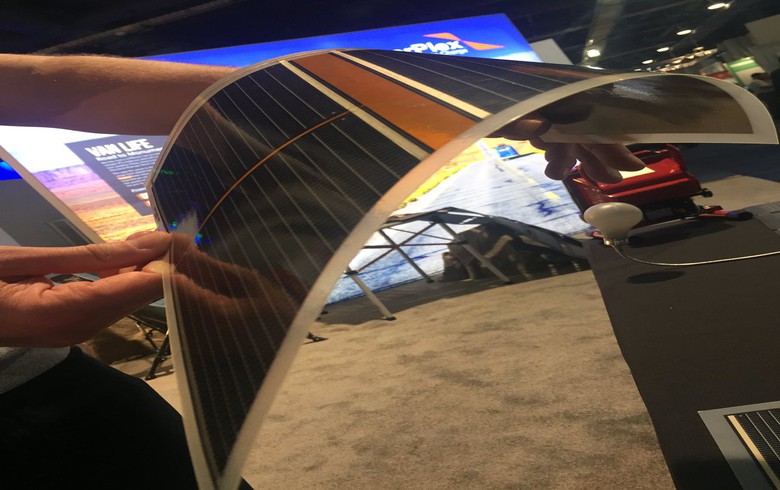
 BioPharma3 years ago
BioPharma3 years agoHumbl Inc (OTCMKTS: HMBL) Major Reversal as Powerful Advisor Rejoins the Team & Looks to Uplist to Major Exchange

